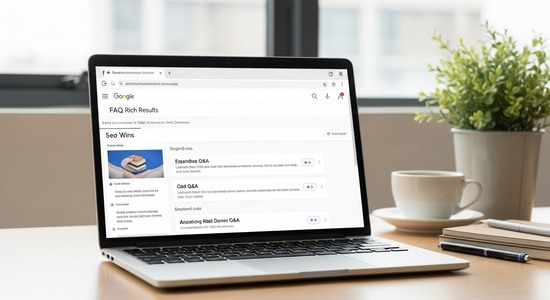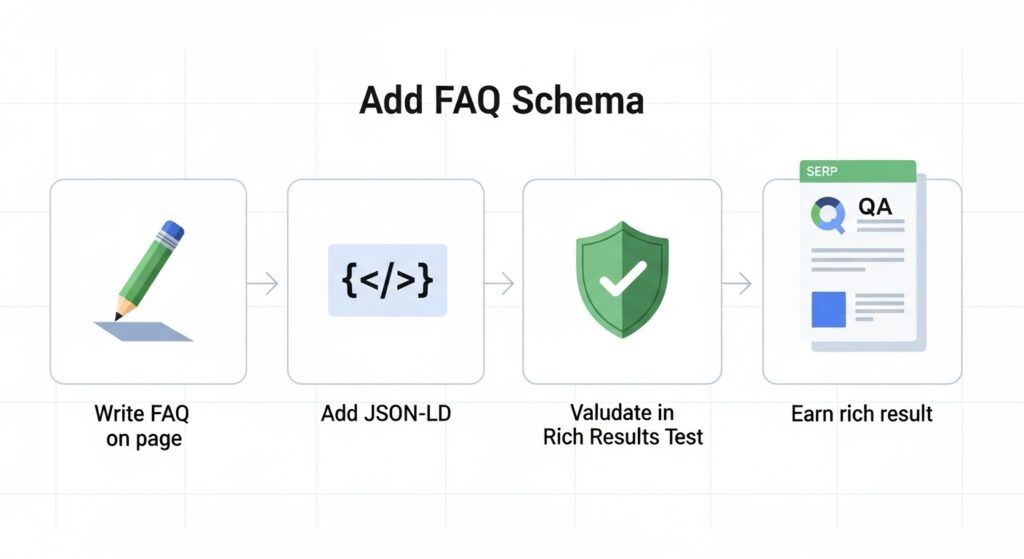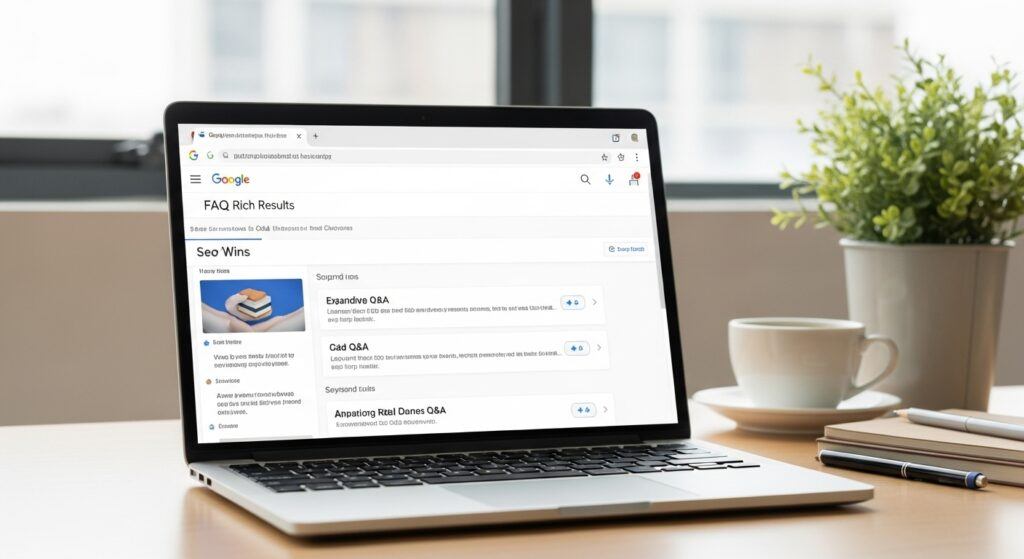
Estimated reading time: 10 minutes
FAQ Schema: Earn Rich Results and Cut Bounce Rate (Beginner Guide)
Struggling with low traffic and high bounce rates? You are not alone. New marketers often publish helpful posts, then watch visitors leave after one page. The fix might be simpler than you think.
FAQ Schema is a small piece of code that tells Google your page includes questions and answers. When it fits the rules, it can show your Q&A right in search as Rich Results. People see quick answers, they click, and they stay longer because they find what they need fast. That means more qualified traffic and fewer one-and-done visits.
If you are starting in affiliate marketing, this matters. It can boost your content’s visibility, making it stand out and helping your niche posts compete for better ranking. In this guide, you will learn what it is, how it helps, and a step-by-step setup you can follow today.
Key takeaway: Add a small, honest FAQ section to your page and mark it up with JSON-LD. This can earn rich results, bring in higher-intent clicks, and keep readers on the page longer, which helps lower bounce rate and grow your affiliate traffic. Validate it, track results in Search Console and Analytics, then refine your questions based on real searches.
What Is FAQ Schema and Why Use It for Better Search Visibility
FAQ schema, also known as FAQPage or the related QAPage schema, is a form of structured data implemented through schema markup, often using microdata as a type of structured data markup. You add it to a page that already has a visible FAQ section. The markup labels each question and answer in a way search engines understand. Think of it like a label maker for your content.
When your page is eligible, Google can show your FAQs in the SERP as an expanded rich result. These are called rich results. Instead of a plain blue link, users see your questions listed below your title. They can expand a question to view a short answer without leaving Google.
Why use it:
- Higher CTR from search because your listing takes up more space and boosts visibility.
- Better intent match because the questions mirror how people search, much like the “People Also Ask” sections in results.
- Clearer context for search engines, which supports your overall SEO.
For affiliate sites, FAQs work well on comparison posts, reviews, and “best of” guides. Answer common doubts that block a purchase. Examples:
- Is this tool safe?
- How does the free trial work?
- What is the refund policy?
- What niche is best for beginners?
A simple rich snippet example: You search “How to choose a niche for affiliate marketing” and see a result with a title, then two expandable questions like “What makes a niche profitable?” and “How many posts do I need to start?” Those quick answers pull attention and invite the click.
Besides visibility, FAQ schema can help reduce bounce rate. It attracts people who search for specific questions. They land on your page, see the answer fast, and often keep reading. You filter out the wrong traffic and keep the right readers.
Note: In recent Google updates, FAQ rich results show less often across the web. They still appear, especially for trusted sites and highly relevant questions. Even when the dropdown does not show, the schema markup can still help search engines understand your content and improve relevance.
How FAQ Schema Leads to Rich Results in Google
Here is how Google works with your schema:
- You add an on-page FAQ section with real questions and clear answers.
- You mark those Q&A pairs with FAQPage schema.
- Google crawls your page and, during indexing, reads the structured data.
- If your content meets Google’s quality guidelines and is eligible, it may display as rich results.
Key elements to get right:
- Real question that matches how users ask them.
- Concise answer that is helpful and under 3,000 characters.
- No promotional fluff in the answers. Keep it factual.
- Visible on the page. Do not hide the FAQ content.
Keep your FAQ set tight. A small set, often 2 to 5 strong questions, works best for clarity.
A quick affiliate example: You publish “How to pick your first affiliate niche.” Your FAQ includes “What niche is easiest for beginners?” and “How do I know if a niche can make money?” These match search intent. If Google shows your FAQs in search, beginners can preview your advice, then click for the full guide.
Bonus: FAQs can help with voice search. When someone asks a question out loud, Google often pulls short, direct answers. Clean Q&A markup increases your odds of being useful in those moments.
The Link Between FAQ Schema and Lower Bounce Rates
Bounce rate is the percent of people who leave after viewing only one page. High bounce rate often means a mismatch between the search query and the content.
FAQ schema helps you meet intent from the first second:
- It brings in visitors who asked those exact questions.
- They get instant answers, which builds trust.
- Clear answers make people curious to read more.
Tips to keep people engaged:
- Match each question to a real search phrase.
- Put the FAQ section above the fold on mobile, or link to it with a jump link.
- Use simple language. Avoid jargon.
- Add internal CTAs to related content, like a full review or a beginner guide.
Recent reports show sites that add helpful, relevant schema often see higher click-through rates and steadier engagement. Some teams also see more time on page and fewer quick exits when the FAQ content directly addresses search intent. For affiliate beginners, add FAQs to review pages to clear doubts early. That small tweak can keep readers around long enough to click your comparison table or try your recommended tool.

Step-by-Step Implementation Guide to Adding FAQ Schema to Your Site
Ready to set it up? Follow these steps.
- Create a real FAQ section
Write 2 to 5 questions users ask. Keep answers short and useful. Place the FAQ near the end of your post or right after your main content. - Use JSON-LD format
JSON-LD is the easiest format to manage. You paste a small script into your page. - Start with a basic template
Replace the sample question and answer with your own. Keep it truthful and helpful. The script uses @type: “FAQPage” from Schema.org.
<script type="application/ld+json">
{
"@context": "https://schema.org",
"@type": "FAQPage",
"mainEntity": [{
"@type": "Question",
"name": "What is the best affiliate program for beginners?",
"acceptedAnswer": {
"@type": "Answer",
"text": "Pick a reputable program with simple terms, solid support, and fair commissions. Start with one program that matches your niche and audience."
}
}]
}
</script>
- Add it to your page
- If you use WordPress, paste the script into the header or use an SEO plugin that supports FAQ schema for your page’s URL.
- If you edit HTML, place the script in the head or just before the closing body tag.
- Make sure the FAQ is visible
Your on-page FAQ must match the schema and be visible on your website. If the content is not visible to users, skip the markup. - Validation
Use Google’s Testing Tool to confirm your FAQ page schema is valid. Fix errors before publishing. - Keep it clean
Do not stuff product promos into answers. Link to deeper content only when it helps. For example, link to your niche guide after answering “How many posts should I publish each week?” - Troubleshooting
- “Invalid object” errors usually mean a missing field. Make sure each question has a name and acceptedAnswer.
- “Not eligible” messages can happen. Check that your FAQ is real, unique, and helpful, following quality guidelines.
- Structured data issues like these can often be resolved by double-checking your implementation.
- If the snippet does not show, give it time. Google decides when to display rich results. You still gain SEO clarity even if the dropdown does not appear.
Tools and Best Practices for Success
- Free tools to help: Structured Data Markup Helper, Rich Results Test, and the Schema.org validator.
- Keep answers factual and current. Update them as your niche changes.
- Do not add unrelated questions. Keep your set tight and relevant.
- Tie FAQs to affiliate content. For example, link from “Is this tool beginner friendly?” to your full review.
- Test on a staging site first. Publish once your markup is error free.
- Start small. Three or four great questions beat a long, weak list.
Measure Your Results and Make Improvements
Tracking is where the wins show up.
- Use Google Search Console
Open the Search results report. Filter for rich results in the SERP to see impressions and clicks for structured data when available. Track queries that match your FAQ questions. - Watch engagement in Analytics
Compare bounce rate and average engagement time on your content before and after adding the FAQ. Segment by landing page. Look for higher engagement on pages with clear, helpful questions. - A/B test your FAQs
Create two versions of a page using a Testing Tool. Keep one with a shorter FAQ set focused on search intent. Keep the other broader. Compare clicks, time on page, and conversions. - Refine your questions
Pull queries from Search Console. Rewrite your FAQ questions to match how people search. Tighten answers. Remove any that get no traction. - Grow with intent
As you publish more affiliate content, add FAQs that address objections, setup steps, or pricing questions. Small changes, made often, add up to steady traffic gains and improved ranking.
Recent case studies and industry roundups in 2025 point to structured data improving clarity for search engines and helping CTR. Even with search engines showing fewer FAQ snippets, matching your Q&A to real search intent still drives better clicks and stronger engagement.
FAQ
-
What is FAQ schema? Quick win
FAQ schema is structured data that marks up a list of questions and answers on a page. It helps Google understand your content and may enable rich results.
-
Do I need a visible FAQ section on the page? Rule
Yes. Only add FAQ schema to pages that display the same Q&A content to users. Hidden FAQs are not eligible.
-
Will FAQ rich results always show? Varies
No. Google decides when to display them. Even if the dropdowns do not appear, the schema can still improve understanding and relevance.
-
How many questions should I include? Best practice
Start with 2 to 5 strong, search-led questions. Keep answers short, clear, and helpful.
-
Can I promote affiliate links in the answers? Caution
Keep answers factual. You can link to deeper content when it helps, but avoid salesy copy or aggressive promos inside the FAQ.
-
Where do I add the JSON-LD code? Setup
Add it in the page head or before the closing body tag. On WordPress, you can use an SEO plugin that supports FAQ schema.
-
How do I validate my FAQ schema? Validate
Use Google’s Rich Results Test. Fix errors like missing fields (name, acceptedAnswer) before publishing.
-
Does FAQ schema help lower bounce rate? Benefit
It can. It attracts visitors who asked those exact questions, so they find answers fast and often keep reading.
-
What should I do if my FAQ snippet doesn’t show? Improve
Give it time, improve quality, and match questions to real queries from Search Console. Keep answers concise and useful.
-
What are good starter questions for affiliate sites? Starter set
Try these: Is this tool safe for beginners? What makes a niche profitable? How many posts should I publish each week? What is the refund policy or trial length?
Conclusion
Implementing the FAQ schema is a smart SEO move that helps you stand out in search, win more clicks, and keep readers on the page. It brings in visitors who want fast answers, which lowers bounce rates and builds trust. If you are new to affiliate marketing, this simple upgrade can move the needle on your next post.
Try it today. Add one focused FAQ to a key page, perform validation on it, and check your results in a week. Then expand to your reviews and comparison guides. Step by step, you will build a website that ranks, earns trust, and grows revenue. Thanks for reading, and keep going. Small wins stack up.

Hi, I’m Michael Gray.
I built Digital Ease Hub because I was tired of the overcomplicated nonsense out there. Starting an online business shouldn’t feel like solving a Rubik’s Cube in the dark. I learned that the hard way — years of trial, error, and plenty of mistakes I wish I could’ve skipped. My goal now is simple: show you the tools that actually make online business and affiliate marketing easier, so you can focus on building income instead of getting lost in the weeds.
Join Me on the Platform I call home and has shown me how to make success a reality.

